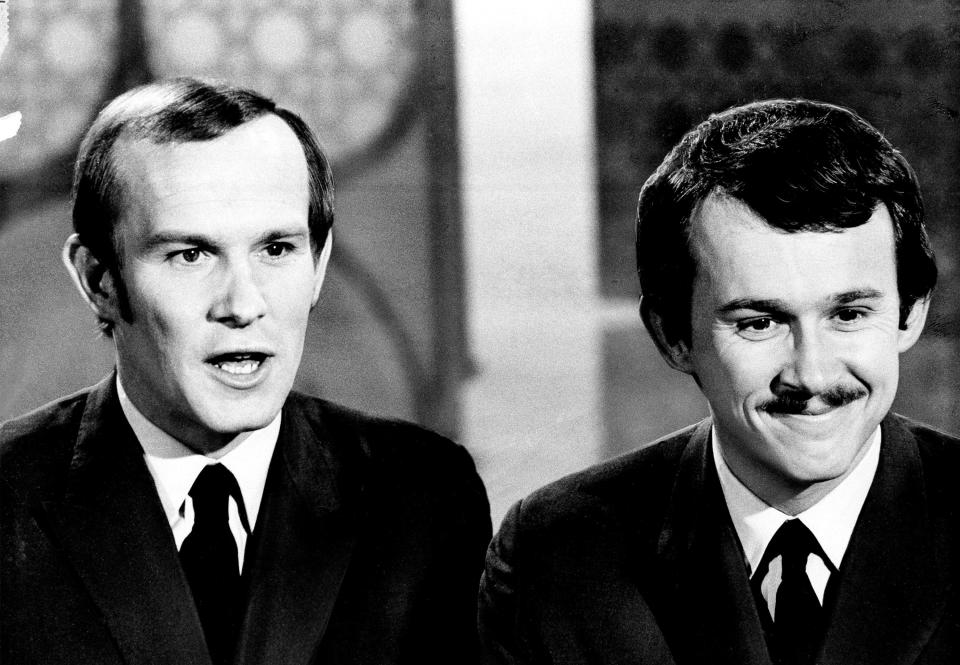1969 flashback: How TV woke up to the counterculture and changed with the times
Fifty years ago, following a headline-making, counterculture-driven summer of Stonewall, Woodstock, Manson, "Easy Rider" and "Midnight Cowboy," the 1969-70 TV season kicked off. And the new schedule suggested that in a country screaming for change, the television networks were listening: The child that was TV was about to grow up.
First out of the gate was ABC’s "Room 222," a half-hour comedy starring Lloyd Haynes as Pete Dixon, a history teacher at the fictional Walt Whitman High School. Demonstrating that TV academia had come a long way since "Our Miss Brooks" in the 1950s, the new series used Dixon’s classroom as a springboard for discussions of hot-button issues like race, gender, religion and war. And it did so with an ethnically diverse, Afro-sporting, bell-bottomed cast of student characters, some of whom were still teens themselves.
That Dixon was involved in a relationship with school counselor Liz McIntyre (Denise Nicholas) only upped the ante of innovation: Few sitcoms of the day featured two black leads, let alone as a romantic pair. The scenario reportedly had nervous ABC executives rethinking the show, but 29-year-old creator-producer James L. Brooks (a year away from "The Mary Tyler Moore Show") insisted "Room 222" would presenti a more accurate picture of contemporary American life.
The series went on to win an Emmy in the (since-eliminated) category of Outstanding New Series, ran for five seasons, during which it continued to offer real-world story line, including a take on the generational divide in a 1970 episode that won a Writers Guild award.
Making real-world inroads of their own that September were CBS's "The Leslie Uggams Show," the first variety-series hosted by a black woman; NBC's "The Bill Cosby Show," the actor’s first solo outing after his "I Spy" success (as well as the first sitcom to feature a black actor’s name in the title); and NBC's "The Courtship of Eddie’s Father," a sitcom that starred Bill Bixby as a single dad and featured an Asian-American as a cast regular. Playing housekeeper Mrs. Livingston, Miyoshi Umeki was not a comic-relief domestic along the lines of the stereotypical Hop Sing of "Bonanza." Instead, she was often the emotional backbone and mother figure of the show.
Other freshman series more overtly nodded to the country’s rising counterculture, among them "The Governor and J.J." (CBS), about a conservative widower dealing with his hippie daughter; "The New People," ABC's "Lost"-meets-the-Peace-Corps drama; "The Music Scene," ABC's rock-and-roll showcase hosted by comedian David Steinberg; NBC's "Then Came Bronson," a drama about a disillusioned young man’s search for meaning; and NBC's "The Bold Ones," an umbrella title for four rotating series that explored the changing faces of the medical, legal, police, and political professions.
Even a pair of conventional medical dramas displayed a sort of generational retrofitting. ABC's "Marcus Welby, M.D." and CBS's "Medical Center" revolved around the conflict of old-guard/new-guard pairings (Robert Young and James Brolin on "Welby," James Daly and Chad Everett on "Medical"). And in early episodes, each dealt with current events like Vietnam refugees and abortion. The doctor-as-savior formula was tweaked, too: In the shades-of-gray world of 1969, medical powers proved limited, and sometimes patients died. (Trivia alert: The patient in Medical Center’s premiere was an "aspiring football star" played by O.J. Simpson.)
Two more new shows that fall best reflected the realities of late-60s culture. ABC's
"The Brady Bunch" had one foot in cookie-cutter sitcom shtick (coming from "Gilligan’s Island" producer Sherwood Schwartz), but planted its other firmly in modern suburbia, reflecting the changing makeup of the American family and innovating with often-dramatic storytelling about day-to-day life as seen through the eyes of the teen generation. For every episode about a dog allergy or a sibling singing contest or hair mistakenly dyed green was another exploring school bullying or social conformity or gender roles – and even race.
In November, on the new PBS network, "Sesame Street" arrived to serve up new ways of looking at both television and childhood learning, featuring a mulligan’s stew of faces and races tackling ideas as well as ABCs.

The generation gap caused by a divided country wasn't totally new to TV in 1969. As much as two years before, "The Smothers Brothers Comedy Hour," "Rowan and Martin’s Laugh-In" and "The Mod Squad" mined countercultural themes.. But the 1969-70 season expanded them greatly.
A prime-time revolution was under way. Television was the portal to a new decade when much of the creative decision-making would come into the hands of the first generation raised on it and awakened by it in the '60s. It was a generation that suspected TV’s reach could extend further – and that audiences were open to it. "Mary Tyler Moore" and "All in the Family" arrived soon after.
The season represented the bridge between prime-time’s then and now, wrapping up in the spring of 1970 with the rules-breaking "Laugh-In" and a legacy western ("Gunsmoke") as the country’s two most popular series.
The end, it appeared, was only the beginning.
Jim McKairnes, a contributor to USA TODAY, is the author of "All in the Decade: 70 Things About '70s TV That Turned Ten Years Into a Revolution."
This article originally appeared on USA TODAY: How TV reflected 1969 counterculture, race and social issues

